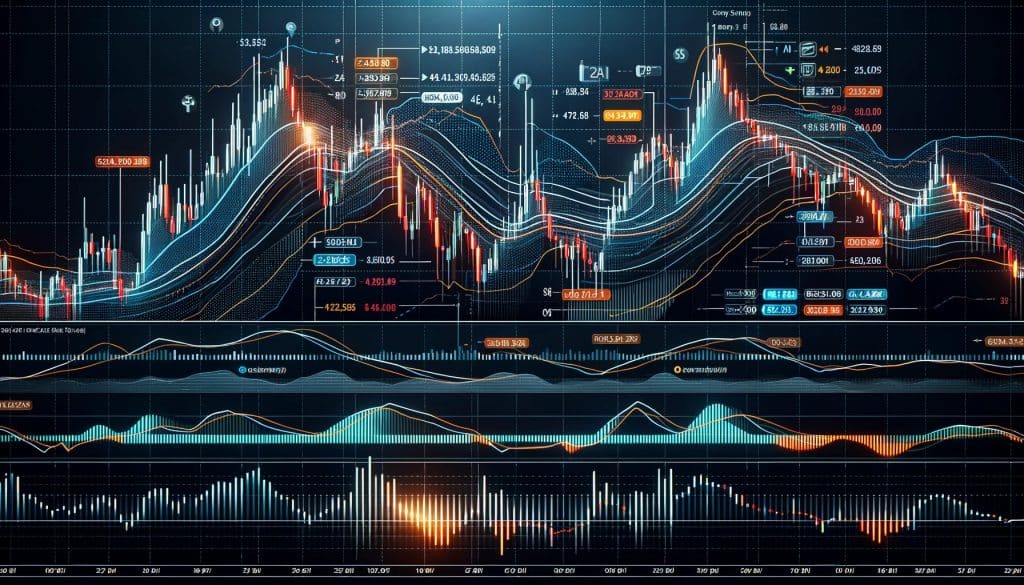The foreign exchange (Forex) market is the largest financial market in the world, known for its volatility and high liquidity. To navigate this complex market, traders rely on various forex indicators to make informed decisions. These tools help in predicting market movements, identifying trends, and determining optimal entry and exit points. This article explores the top 10 forex indicators every trader should know and use, offering insights into how these tools can significantly improve trading strategies.

Top 10 Forex Indicators
Moving Average (MA)
The Moving Average is a fundamental forex indicator that helps traders identify the market trend by smoothing out price data over a specific period. It comes in various forms, such as the Simple Moving Average (SMA) and the Exponential Moving Average (EMA), each providing insights into short-term and long-term market trends. Utilizing MAs, traders can determine bullish or bearish market conditions and make strategic trading decisions accordingly.
Relative Strength Index (RSI)
The RSI is a momentum oscillator that measures the speed and change of price movements, indicating overbought or oversold conditions. By comparing the magnitude of recent gains to recent losses, the RSI helps traders identify potential reversals and corrective movements, making it an invaluable tool for market analysis.
Bollinger Bands
Bollinger Bands consist of a middle band being a moving average, with two outer bands that expand or contract based on market volatility. This indicator is instrumental in identifying market conditions, providing signals for potential tops and bottoms, and breakout points. Traders use Bollinger Bands to gauge market momentum and volatility, adjusting their strategies to align with current market conditions.
Stochastic Oscillator
The Stochastic Oscillator compares a particular closing price of an asset to a range of its prices over a certain period. This indicator helps traders identify overbought and oversold conditions, offering insights into potential reversal points. It’s particularly useful in ranging markets, where these conditions are more pronounced.
Fibonacci Retracement
Fibonacci Retracement is a technical analysis tool that uses horizontal lines to indicate areas of support or resistance at the key Fibonacci levels before the market continues in the original direction. Traders use these levels as potential buy or sell points, integrating them into their trading strategies for enhanced decision-making.
Moving Average Convergence Divergence (MACD)
The MACD is a trend-following momentum indicator that shows the relationship between two moving averages of a security’s price. It helps traders identify trend direction, momentum, and potential reversals. The MACD consists of the MACD line, signal line, and histogram, each offering different signals for trading opportunities.
Parabolic SAR
The Parabolic SAR (Stop and Reverse) helps traders identify the end of a trend and the beginning of a new one. It provides clear entry and exit points, making it a favorite among traders looking to capitalize on short-term market movements. The indicator is represented as dots above or below the price, indicating the current trend direction.
Ichimoku Cloud
The Ichimoku Cloud offers a comprehensive view of the market by combining five indicators into one. It provides information on support and resistance levels, trend direction, and momentum. The cloud’s visual representation makes it easy for traders to interpret market conditions at a glance, aiding in quick decision-making.
Average True Range (ATR)
The ATR indicator measures market volatility by decomposing the entire range of an asset for that period. High ATR values indicate high volatility, while low ATR values suggest low volatility. Traders use the ATR to adjust their trade size and manage risk, making it a crucial tool for effective risk management.
Pivot Point
Pivot Points are used to determine critical support and resistance levels. It’s a predictive indicator, based on the calculation of the average of the high, low, and closing prices from the previous trading day. Traders use pivot points to identify potential reversal points, making it an essential tool for intraday trading.

How to Choose the Right Forex Indicator
Choosing the right forex indicator depends on your trading style, objectives, and the market conditions. Consider factors such as the indicator’s responsiveness to price changes, its ability to filter noise, and its success rate in generating accurate signals. It’s often beneficial to combine indicators to get a more comprehensive view of the market.
Combining Forex Indicators
Combining forex indicators can provide a more robust trading strategy. For example, using a trend indicator like the MA with a momentum indicator like the RSI can validate trade signals, increasing the probability of success. However, it’s crucial to understand how these indicators interact and to avoid redundancy, which can lead to overcomplication and conflicting signals.
Practical Tips for Using Forex Indicators
To maximize the benefits of forex indicators, start with a clear understanding of what each indicator represents and its limitations. Practice on a demo account to get a feel for how these indicators work in real-time market conditions. Always remember to keep your trading strategy simple; using too many indicators can lead to analysis paralysis.

The Impact of Forex Indicators on Trading Strategy
Incorporating forex indicators into your trading strategy can significantly enhance your market analysis and decision-making process. They provide objective data and insights, helping to reduce emotional trading and increase consistency in your trading approach.
Advanced Techniques in Forex Indicators
For experienced traders, exploring advanced techniques and custom indicators can open up new opportunities for market analysis and strategy development. Custom indicators, tailored to specific trading strategies or market conditions, can provide a competitive edge.
Challenges and Limitations of Forex Indicators
Despite their usefulness, forex indicators are not foolproof and come with limitations. False signals and lagging indicators can lead to missed opportunities or losses. It’s essential to understand these challenges and to use indicators as part of a comprehensive trading plan that includes risk management and a clear understanding of market dynamics.

FAQs on Top 10 Forex Indicators
How do I know which forex indicator is best for my trading style?
Consider your trading style, the types of analysis you’re comfortable with, and the specific goals you have for trading. Experiment with different indicators to see which ones align best with your strategy.
Can I rely solely on forex indicators for trading decisions?
While forex indicators are valuable tools, they should not be the sole basis for trading decisions. Combine them with other forms of analysis, such as fundamental analysis and market sentiment, for a well-rounded approach.
How many indicators should I use at once?
It’s advisable to use a few complementary indicators rather than cluttering your analysis with too many signals. A combination of 2-3 indicators is often sufficient to provide clear, actionable insights.
Are forex indicators effective in all market conditions?
No single indicator works best in all market conditions. It’s important to adapt your indicator usage to align with current market dynamics and to be aware of the limitations of each tool.
How can I avoid false signals from forex indicators?
Look for confirmation from multiple indicators or other forms of analysis. Setting tighter parameters and focusing on higher time frames can also help reduce the likelihood of false signals.

Conclusion
Forex indicators are indispensable tools for traders, offering insights into market trends, momentum, and potential reversal points. By understanding and effectively using these top 10 forex indicators, traders can enhance their market analysis, improve their decision-making, and increase their chances of trading success. Remember, no indicator is perfect, and a successful trading strategy involves a mix of technical analysis, fundamental insights, and sound risk management practices.





